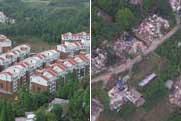China
Full Text: China´s National Defense in 2006
IV. The People's Liberation Army
To effectively fulfill its historic mission in the new stage of the new century, the PLA is speeding up the revolution in military affairs with Chinese features and enhancing in an all-round way its capabilities of defensive operations under conditions of informationization.
Completing the Reduction of 200,000 Troops
In 1985, 1997 and 2003, China announced that it would cut the size of the PLA by one million, 500,000 and 200,000 persons, respectively. By the end of 2005, China had completed reducing the PLA by 200,000 troops, and the PLA currently has 2.3 million troops. The PLA has made new progress towards the goal of being proper in size, optimal in structure, streamlined in organization, swift and flexible in command, and powerful in fighting capacity.
Downsizing the PLA. The Army was the focus of force reduction, and its authorized number of personnel has been reduced by more than 130,000. Over 60,000 military personnel have been removed from the headquarters and directly affiliated units of military area commands and provincial military commands. Through restructuring, the proportion of the Navy, Air Force and Second Artillery Force in the PLA has been raised by 3.8 percent while that of the Army has been lowered by 1.5 percent.
Streamlining the headquarters and directly affiliated units as well as educational institutions. More than 3,000 departments of and over 400 units directly affiliated to the headquarters at and above the regimental level have been cut. A considerable number of agricultural and sideline production units, cultural and sports units, military representative offices at railway stations and material supply organs have been closed. The PLA has also closed 15 educational institutions and 31 training organizations.
Improving the structure of services and arms. The Army has cut a number of combined corps, divisions and regiments, increased the number of combined corps whose order of battle is corps, brigade and battalion, and set up units with new and high-tech weaponry and equipment. The Navy and Air Force have cut some ship groups and aviation divisions, regiments and stations, and set up some high-tech surface ship, aviation and ground-to-air missile units. A number of reserve infantry divisions have been dismantled, but the number of divisions (brigades) of other arms has increased.
Reforming the leadership and command system. The leadership and command system of the general headquarters/departments has been enhanced through adjusting the functions of relevant departments and improving joint operational command. The Navy has cut the naval aviation department and converted naval bases into support ones. The Air Force has closed corps (base) headquarters and set up regional command posts. Following these adjustments, the combat troops of the Navy and Air Force are now directly under the fleets and the air commands of the military areas, respectively.
Deepening the reform of the joint logistical support system. The joint logistical support system, based on military area commands, has been expanded, and overlapping support organizations reduced. Apart from special-purpose depots and general hospitals under the general headquarters/departments, the Navy, Air Force and Second Artillery Force, all the other rear depots, hospitals and recuperation centers have been integrated and reorganized into the joint logistical support system. A total of eight joint logistical sub-departments (offices), 94 rear depots, and 47 hospitals and recuperation centers have been closed.
Improving the ratio between officers and men. The PLA has reduced the number of its officers by 170,000. More than 150 officer posts at or above the corps level have been eliminated, nearly 70,000 posts formerly taken by officers are now filled with non-commissioned officers (NCOs), and over 20,000 posts formerly taken by NCOs are now filled with contract civilians.



